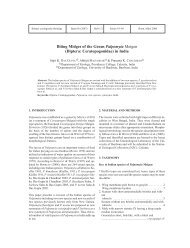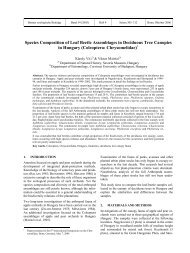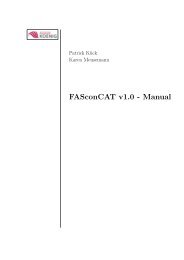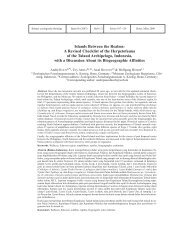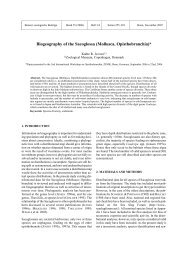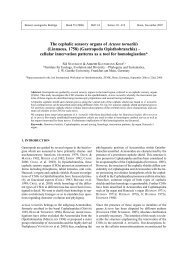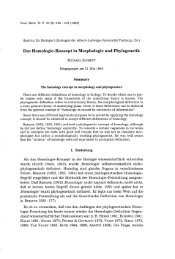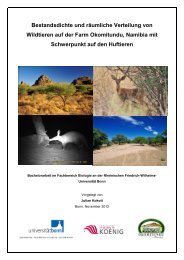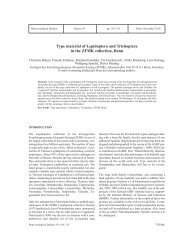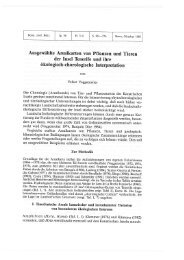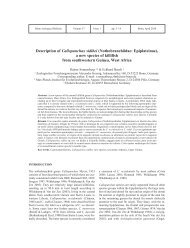Successful Husbandry and First Breeding of Varanus juxtindicus ...
Successful Husbandry and First Breeding of Varanus juxtindicus ...
Successful Husbandry and First Breeding of Varanus juxtindicus ...
You also want an ePaper? Increase the reach of your titles
YUMPU automatically turns print PDFs into web optimized ePapers that Google loves.
Fig. 1. Juvenile paratype <strong>of</strong> <strong>Varanus</strong> <strong>juxtindicus</strong> (ZMUC E617), dorsal (A) <strong>and</strong> ventral side (B). Photographs by<br />
Mogens Andersen.<br />
Alex<strong>and</strong>er Koenig (ZFMK), Bonn, Germany (Böhme<br />
et al., 2002). Thus, V. <strong>juxtindicus</strong> has to be regarded<br />
as one <strong>of</strong> the least known <strong>and</strong> rarest monitor species<br />
<strong>of</strong> the world (Böhme et al., 2004). Due to its assumed<br />
close relationship <strong>and</strong> phenotypic similarity with the<br />
widespread mangrove monitor (V. indicus) consisting<br />
<strong>of</strong> a dark background coloration mottled with numerous<br />
yellow scales, V. <strong>juxtindicus</strong> obtained its scientific<br />
species name (from Latin iuxta = “next to” or “close<br />
to”). The species is distinguished from all other members<br />
<strong>of</strong> the V. indicus species group (V. caerulivirens, V.<br />
cerambonensis, V. doreanus, V. finschi, V. indicus, V.<br />
jobiensis, V. lirungensis, V. melinus, V. rainerguentheri,<br />
V. yuwonoi, <strong>and</strong> V. zugorum) by its tail shape (Fig. 2),<br />
which is roundish in its first third <strong>and</strong> lacks a differentiated<br />
double keel on its dorsal ridge (Böhme et al., 2002).<br />
Fig. 2. Characteristic for V. <strong>juxtindicus</strong>: the tail lacks<br />
a distinct dorsal double keel. Photograph by André<br />
Koch.<br />
BIAWAK VOL. 3 NO. 4<br />
A B<br />
107<br />
A photograph <strong>of</strong> a juvenile V. <strong>juxtindicus</strong> (Fig. 3)<br />
taken by Gunther Köhler (Frankfurt) from the <strong>of</strong>fspring<br />
<strong>of</strong> Klaus Wesiak (KW) was published more than ten<br />
years ago in Bennett (1996: 203; 1998: 191) <strong>and</strong> again in<br />
Eidenmüller (1997: 64). In Bennett (1998: 124), another<br />
specimen bred by KW is shown at the age <strong>of</strong> one <strong>and</strong> a<br />
half years (photograph by Felix Hulbert). Remarkably,<br />
the color pattern <strong>of</strong> this specimen is very bright yellowishgreen<br />
(Fig. 4). While the lack <strong>of</strong> the characteristic dorsal<br />
double keel as typical for V. <strong>juxtindicus</strong> is hardly visible<br />
in the juvenile specimen mentioned above, the tail <strong>of</strong> the<br />
adult specimen is obviously roundish <strong>and</strong> not laterally<br />
compressed. However, this confusion seems to have not<br />
Fig. 3. Juvenile V. <strong>juxtindicus</strong>. Photograph by Gunther<br />
Köhler.




